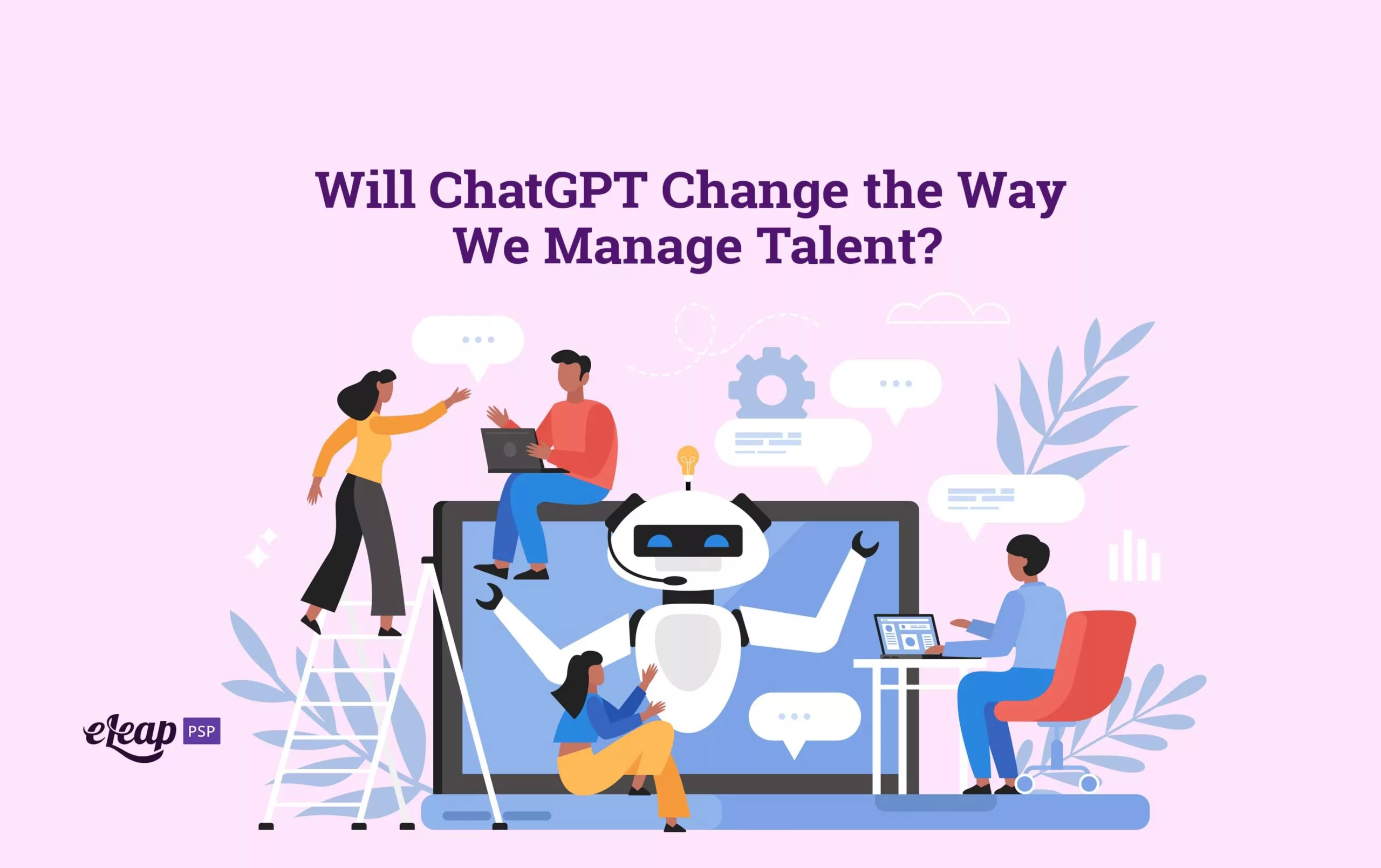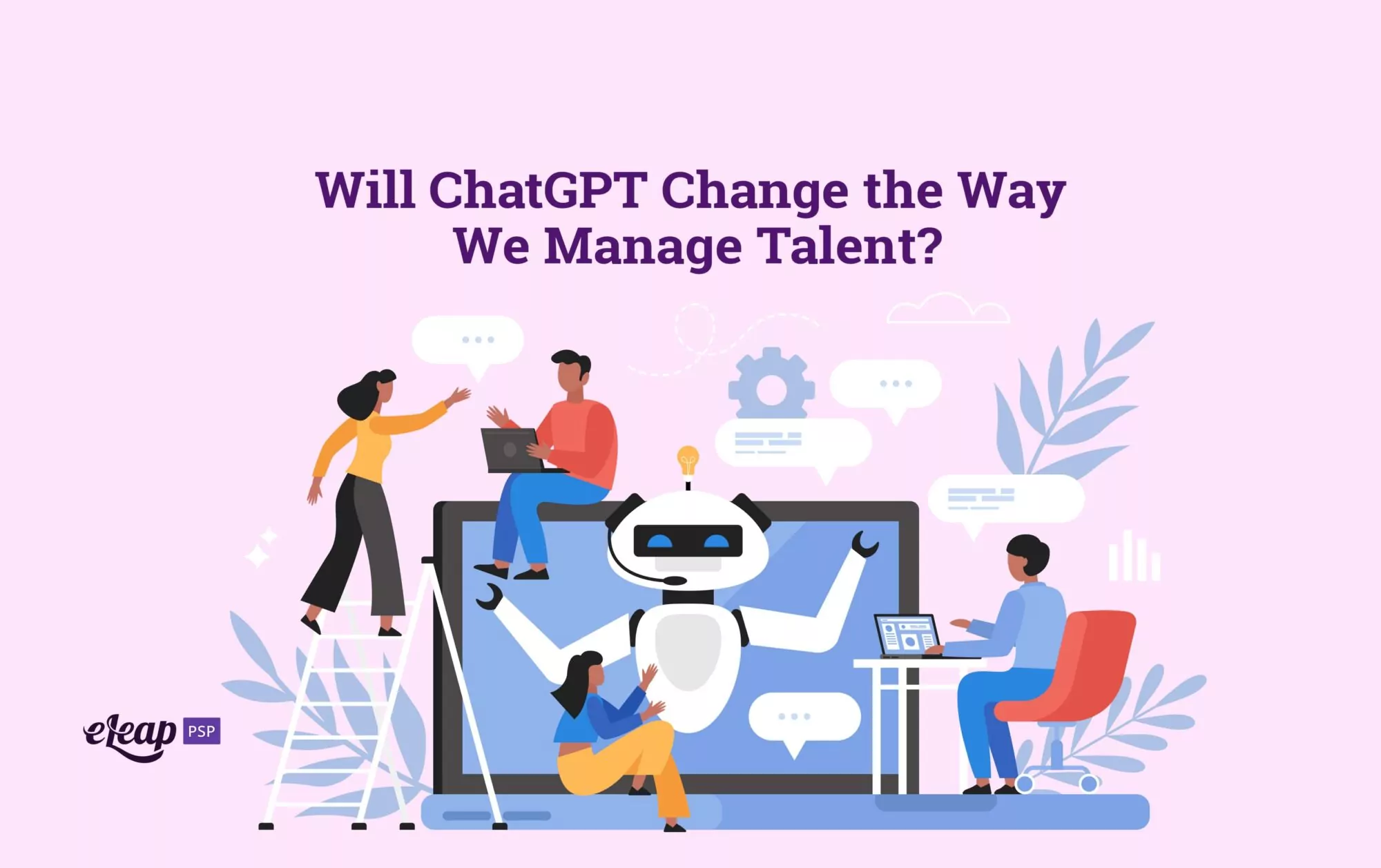Will ChatGPT Change the Way We Manage Talent, HR?

Managing talent has always been a challenge for organizations, but the task has become even more daunting as the world becomes more complex and diverse. The old ways of recruiting, training, reviewing, engaging, and retaining employees are no longer enough to keep up with the demands of the modern workforce. The rise of AI in all its manifestations, including chatbots, purports to deliver interesting advantages. The latest in this AI craze is ChatGPT. Explore how eLeaP®’s Performance Management Platform can simplify evaluations, boost productivity, and drive measurable results.

ChatGPT is an AI chatbot that can interact with employees in natural language. It provides personalized solutions to various HR-related issues based on GPT (Generative Pre-trained Transformer), a machine learning model pre-trained on vast amounts of text data to generate natural-sounding responses to user queries. With its potential to automate tasks, predict employee behavior, and enhance the employee experience, ChatGPT appears poised to change the game for HR professionals.
However, despite the rave reviews and seemingly incredible features, this chatbot has several disadvantages. Therefore, if you’re a business leader, an HR executive, or an employee, this blog post will help you decide whether to be worried about ChatGPT’s rise.
How Will ChatGPT Change the Way We Manage Talent?
The following are ways this AI chatbot can help talent managers:
Crafting Job Descriptions
Writing a good JD that spells out everything applicants need to know before applying takes time and effort. If well written, a good job description will help attract the right talents, while a bad one will make the hiring process stressful. Crafting a befitting job description is one of the challenges many in HR face. With ChatGPT, hiring managers can wave goodbye to the stress accompanying this part of the hiring process.
According to the Society for Human Resource Management (SHRM), this chatbot allows you to quickly create a good job description. All you need to do is type the title of the vacant position, the required experience, and any other relevant information—for example, a job description for a software developer with 7 years of experience in development. In seconds, ChatGPT would spit out a job description you could paste into your Applicant Tracking System.
Generating Interview Questions
One of the most critical steps in hiring talents is the interview process. Since it dramatically depends on the quality of the questions you ask, you can understand how fraught this process can get. Asking appropriate questions can reveal the skills and capabilities of an applicant, but drafting such questions takes time and energy. However, ChatGPT has changed this narrative, as you can generate endless interview questions quickly. For example, interview questions on marketing management
Developing Performance Reviews
Yes, we know. Many of you don’t want to take the time to reflect and write personal performance reviews for your reports and team members. Like most things today, folks prefer ‘suggested’ responses to put down in their reviews. We get it. For those inclined to do this, plenty of AI resources help you generate questions and evaluation entries. It also can be used to create ideas for your self-assessment entries. While we can stop anyone from using ChatGPT for review suggestions, do take the time to edit the entries to suit the person you are reviewing or evaluating.
Enhanced Employee Experience
This chatbot provides personalized support to employees by answering their questions and offering training and development opportunities. It analyzes employee data, including skills, job roles, and career goals, helping them stay engaged and grow in their respective positions and careers. A report by McKinsey found that companies using chatbots or other AI-powered tools to assist employees in their work have seen significant improvements in employee productivity and satisfaction.
Other ways ChatGPT helps to enhance employee experience include:
- Improved communication: Employees can communicate with this chatbot to get answers to HR questions. Some employees might feel reluctant to ask specific HR questions from HR professionals, but with AI-powered chatbots, they can get quick and consistent responses without too much stress. This also helps to reduce the workload on HR personnel.
- Recognition and rewards: AI-powered tools make it easier to track employee performance. The traditional method of monitoring employee progress leaves room for bias and favoritism, as HR personnel may focus more on the progress of some employees than others. While some bias can be detected in some AI systems, on balance, they are designed to reduce bias and level the playing field, so to speak. AI chatbots like ChatGPT can provide real-time feedback, recognition, and rewards. This can help inspire employees, improve their productivity, and boost job satisfaction. Regardless of which side of the AI coin you fall on, people and success platforms like eLeaP provide a reliable and easy-to-use platform to monitor your employee’s progress.
- Health and wellness: Supporting employees’ health and wellness has become easier. AI-powered tools like ChatGPT can help employees with their mental health challenges. The chatbot can help manage stress, create a healthy and supportive work environment, and improve the employee experience.
Predicting Employee Behavior
ChatGPT can help HR managers identify potential red flags regarding which employees are more likely to leave the organization. While no system is 100% foolproof, intelligent systems can use data and analytics to pick up on retention signals that can then be acted on. It can also identify the factors contributing to low engagement and suggest ways to boost employee satisfaction. It does this through the following analysis:
- Text analysis: this chatbot could analyze text-based data sources, including chat logs, comments, employee surveys, social media posts, and emails, to identify common trends, sentiments, and language patterns. Analyzing information from these sources can help predict certain employee behaviors.
- Natural language processing: HR managers can use ChatGPT to analyze written or spoken language to find cues related to employee behavior. For instance, it can help detect language patterns that suggest employees are dissatisfied with their jobs. This information can help HR managers and business leaders proactively address issues before they become problems.
- Predictive modeling: This Chatbot can utilize the insights obtained from natural language processing and text analysis to develop predictive models that identify the likelihood of certain employee behaviors occurring. For instance, HR managers can create a model with this chatbot to predict the probability of an employee engaging in unethical conduct or achieving high levels of job performance.
Caveat: Most or all of these examples are based on existing research, which can be influenced by stakeholders seeking to drive an agenda. Therefore, it is essential to consider them with a healthy dose of skepticism. While the promise is great, we know not everything is as it appears. To this point, we attempt to present the other side of the argument.
The Current Downsides of ChatGPT
Some of the ways ChatGPT can affect business leaders and employees include:
It makes people lazy to think
Critical thinking is an essential tool for organizational growth. Unfortunately, ChatGPT has come to steal that away from people as it provides shortcuts to almost everything. Creativity and critical problem-solving skills will disappear if business leaders rely on machines to think for them. This can lead to catastrophic results and consequences.
The information they provide may not always be correct
ChatGPT cannot distinguish between reliable sources and opinions shared on social media. Therefore, some of the answers it providaren’tn’t always reliable. This is a major flaw that could negate t “the “time savi” “factor of the chatbot for HR teams, as they need to double-check its claims and information.
It only leverages data from before 2021
According to AI Multiple, ChatGPT only leverages data from before 2021. An article by Harvard Business Review, titled Generative Won’Won’tolutionize Search — Yet, also confirmed that ChatGPT was trained on a massive dataset with an October 2021 cut-off. This means we can not have updated and accurate output in some cases. For instance, in areas like law and regulations. If there are any changes to employment laws or regulations after 2021, relying on the chatbot to help in such cases might be catastrophic and put your organization in legal jeopardy. The HBR article further expanded on this point. According to the article, as far as ChatGPT is concerned, Russia hasn’t invaded Ukraine, FTX is a successful crypto exchange, Queen Elizabeth is alive, and it hasn’t reached the Omicron stage. This is likely why, in December 2022, OpenAI CEO Sam Altman said, “It’s time to rely on [ChatGPT] for anything important right now.”
Conclusion
The introduction of ChatGPT into HR is just the beginning of a new era of talent management. With artificial intelligence at our fingertips, we can unlock new possibilities for creating a happier, more productive, and more inclusive workplace. ChatGPT has the potential to streamline HR processes, reduce bias, and improve overall employee engagement and satisfaction. It can also enable HR professionals to focus on higher-value tasks that require more complex decision-making and creativity.
On the other hand, while ChatGPT has proven to be a valuable tool, it is crucial to recognize its downsides to HR, employers, and employees. As with any technology, there are limitations to what it can do and the risks it poses. HR and employers must be aware of these downsides and take steps to mitigate them, such as providing clear guidelines for using ChatGPT and ensuring that employees can access human support when needed. Ultimately, it is up to us to balance the benefits and drawbacks of ChatGPT and other technologies to create a workplace that is both efficient and supportive of humans.